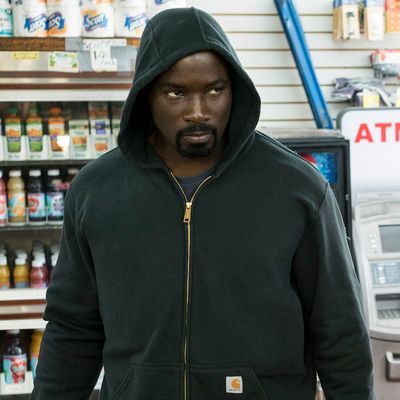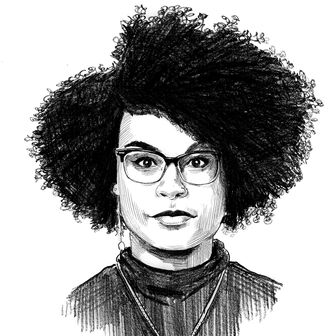
What does it mean for a black man to be a hero?
Especially today, when real black people are killed simply for existing. Especially when blackness itself continues to be pathologized, stolen from, and scorned. This is the landscape Luke Cage was born into, and it’s easy to see how the writers took these issues as a burden, particularly considering Marvel’s dismal track record when it comes to diversity. Unfortunately, that quest for importance has put a stranglehold on the series. Yes, Luke Cage is relevant, but is it really any good?
“Soliloquy of Chaos” answers that question by putting the best and worst aspects of the series next to each other. Although it’s one of the better episodes of the back half of the season, it’s also one of the most infuriating. There are fun moments, like when Luke meets Method Man, but the episode ends on its least compelling plot line yet. During a barbershop parlay meeting, Mariah and Shades make a tantalizing offer: If Luke goes after Diamondback, they’ll give him the proof he needs to prove his innocence. But Diamondback makes a grand entrance with a grenade, as villains of his ilk are wont to do. He’s wearing an ostentatious green suit and helmet that nods to his comic beginnings and grant him abilities similar to Luke’s. “What type of Jean Paul Gaultier shit is this?” Bobby asks when he sees Diamondback’s ridiculous getup. “What are you, the pimp stormtrooper?”
There’s a lot going on in this episode, including Candace revealing that Mariah killed Cottonmouth to Misty. We also see Shades narrowly escape a hit and kill Zip. Luke Cage is meandering its way toward a conclusion, which is evident in how the episode’s runtime edges over an hour even though it doesn’t properly make use of such an extended length.
After getting arrested at the end of the last episode, Luke is able to break through the chains holding him and escapes police custody. He doesn’t have many places to turn, but it’s obvious that the people of Harlem are in his corner. In that way, the episode acts as a thesis statement for the series’ approach to black heroism. “Why is Luke Cage running?” Inspector Priscilla Ridley asks. Misty’s answer says it all: “He’s a black man…”
The people of Harlem have crafted Luke as a folk hero who cares about the dynamics of their life. Even a black cop lets him go free during a chase, despite the fact that Luke still refuses to call himself a hero. As I’ve written in previous recaps, this reluctance has dragged on far too long. It reminds us that Luke is a hollow emblem, a hero with no humanity. He is too noble, too faultless to seem real. Even the civil rights heroes whom the series frequently references weren’t perfect. The problem with Luke Cage is that it implicitly endorses the mythical perfection of men like Martin Luther King Jr., then deploys similar mythologizing to craft its own hero.
As I watched this episode, I couldn’t help but think of another black character who was put in a similar position over 20 years ago: Captain Benjamin Sisko of Star Trek: Deep Space Nine. As the first black man to helm a Star Trek series, Sisko was an important first. Unlike Luke, though, Sisko was allowed to be a man, rather than a symbol burdened by respectability politics. He was intelligent, aggressive, sexy, and morally complex in ways no Star Trek captain has been before or since. By comparison, Luke is an empty figure, albeit an important one.
While trying to keep his head down as a fugitive, Luke comes across two robbers (who are dumb enough to mention their names) holding up a corner store. Aside from the owner, there is just one customer inside: rapper Method Man making a cameo as himself. Method Man and Luke go full fanboy over each other. What’s great about the scene is that it has a levity that Luke Cage rarely exhibits. Luke feels a little more looser here, and in turn more human. He and Method Man even trade hoodies. Obviously, walking around with a black hoodie full of bullet holes calls attention to him. Soon enough, his holey black hoodie becomes a symbol that nods to both his role as a folk hero and the legacy of Trayvon Martin.
On Sway’s radio show, Method Man talks about his encounter with Luke. He endlessly flatters him, saying how without Luke’s intervention he may have been killed. The writers could have stopped there — it would have been enough. But instead, they run this praise into the ground when Method Man freestyles about Luke.
We hear Method Man over images of black men in Harlem wearing hoodies full of holes as a mark of solidarity with Luke, their faces defiant in the face of cops patrolling the streets. “Who to call when no one obeys the law / And there ain’t no Iron Man to come save us all,” Method Man raps. He takes it a step further comparing Luke to Malcolm X and Martin Luther King Jr., as if he is a heir to their powerful legacies. But is he? What has Luke really done for the people of Harlem? The only reason he goes back to the city is to stop Diamondback — and even that is something Claire had to convince him to do. Watching these scenes in which Luke is not only crowned as a hero on par with Malcolm X may seem powerful, but it’s nevertheless unearned.
The sequence underscores the central goal of Luke Cage to create new images of heroism for the black community. But whose blackness does it speak to? It doesn’t speak to mine, except with regards to the women on the series. Luke Cage may have failed in its quest to reconfigure black heroism, but at least Mariah Dillard has upended our expectations of what an television antihero can be. That’s no small accomplishment.
With Shades giving up the last piece of evidence that could tie Mariah to the murder of Cottonmouth, they have cemented their partnership. At this point, Mariah admits she’s out of the political game. She has fully embraced her role as a queenpin under the guise of community outreach and rebuilding Harlem’s Paradise. Mariah even tells Shades, “[Cottonmouth] saw things in me I avoided my whole life. Now I am becoming that person he always saw and I always denied.”
Luke Cage inhabits its ambition and revolutionary desires when it focuses on female characters like Mariah. But as the series shambles toward its finale, I’ve realized that those female characters aren’t enough to distract from the show’s deeply embedded issues. I’m not just talking about the messy structure or how lackluster Diamondback is. Luke Cage failed to create the hero it so desperately wanted because it couldn’t imagine him as a man first.





